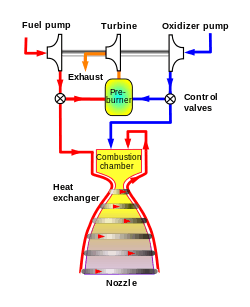Gas-generator cycle

The gas-generator cycle is a power cycle of a bipropellant rocket engine. Some of the propellant is burned in a gas generator and the resulting hot gas is used to power the engine's pumps. The gas is then exhausted. Because something is "thrown away" this type of engine is also known as open cycle.
There are several advantages to the gas-generator cycle over its counterpart, the staged combustion cycle. The gas generator turbine does not need to deal with the counter pressure of injecting the exhaust into the combustion chamber. This simplifies plumbing and turbine design, and results in a less expensive and lighter engine.
The main disadvantage is lost efficiency due to discarded propellant. Gas-generator cycles tend to have lower specific impulse than staged combustion cycles. However there are forms of the gas-generator cycle that recycle the exhaust into the nozzle of the rocket engine. This is seen in the F-1 rocket engine used on the Saturn V booster stage.
As in most cryogenic rocket engines, some of the fuel in a gas-generator cycle may be used to cool the nozzle and combustion chamber (regenerative cooling). [1] The ultimate performance of a rocket engine is primarily limited by the ability of the construction materials to withstand the extreme temperatures of rocket combustion processes, as a higher temperature directly increases the local speed of sound that limits exhaust velocity. [2]
Usage
Gas-generator combustion engines include the following:
Rocket launch systems that use gas-generator combustion engines:
See also
References
- ↑ "ch2-6". nasa.gov.
- ↑ "Mass Flow Choking". nasa.gov.
- 1 2 "Vulcain-2 Cryogenic Engine Passes First Test with New Nozzle Extension" (PDF). ESA.
- ↑ "SpaceX Merlin Engine". SpaceX. Archived from the original on 2011-01-03.
- 1 2 "Delta 4 Data Sheet".
- ↑ Joe Stangeland. "Turbopumps for Liquid Rocket Engines". Archived from the original on 2012-10-18.
- ↑ "J-2X Engine".
- 1 2 "F-1 Engine Fact Sheet" (PDF).
- ↑ "RD-107". Encyclopedia Astronautica. Archived from the original on 2014-02-09.
- 1 2 Asraff, A and Muthukumar, R and Ramnathan, T and Balan, C (2008). Structural Analysis of Propulsion System Components of an Indigenous Cryogenic Rocket Engine. 44TH AIAA/ASME/SAE/ASEE JOINT PROPULSION CONFERENCE & EXHIBIT. doi:10.2514/6.2008-5120.
- ↑ "Falcon 9 Overview". Archived from the original on 2013-05-01.
- ↑ "Falcon Heavy Overview".
- ↑ "Advanced Rocket Engines" (PDF). Institute of Space Propulsion, German Aerospace Center (DLR). Archived from the original (PDF) on 2012-09-04.